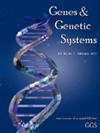在黑腹果蝇中,一个新的enk14等位基因导致了多精。
IF 1
4区 生物学
Q4 BIOCHEMISTRY & MOLECULAR BIOLOGY
引用次数: 0
摘要
一个自发突变,enNK14,是黑腹果蝇的一个新的等位基因。enNK14的雌性在不同的发育温度下有三个受精囊,而不是野生型的两个,而雄性没有表现出异常表型。突变雌性的精子库可以接受受精的精子,尽管与野生型相比,完全接受精子至少要延迟一个小时。突变体和野生型精子数量减少的时间过程完全相似。enNK14雌性比野生型雌性产生更少的后代,尽管储存了大量的精子。精子进入的延迟和繁殖力的降低表明受精囊分泌产物存在一些功能缺陷。此外,突变体中的一些受精囊在包膜周围的脂肪组织中伴有大量棕色色素。enNK14中的六个相邻氨基酸Ser340-Ala345被一个Thr取代。在另一个突变体enspt中,Ser325也被Cys取代。这些氨基酸变化位于富含丝氨酸的区域内,其中Ser325、Ser340和Thr341通过计算机分析被认为是蛋白激酶C的靶标。enNK14与野生型在胚胎、幼虫、蛹和成虫中的en mRNA剪接模式没有差异。我们的研究结果表明,en在决定果蝇雌性受精囊数量和精子储存功能方面发挥着重要作用。本文章由计算机程序翻译,如有差异,请以英文原文为准。
A new allele of engrailed, enNK14, causes supernumerary spermathecae in Drosophila melanogaster.
A spontaneous mutation, enNK14, was a new allele of engrailed (en) in Drosophila melanogaster. Females of enNK14 have three spermathecae, instead of two in wild type, under a wide range of developmental temperatures, while the males show no abnormal phenotype. Spermathecae of the mutant female can accept inseminated sperms, albeit with a delay of at least an hour until full acceptance compared with wild type. The time course of decrease in the number of stored sperms was thoroughly similar between the mutant and wild type. enNK14 females produced fewer progeny than wild type females despite storing a larger number of sperms. The delay of sperm entry and lower fecundity suggested some functional defects in secretory products of the spermathecae. In addition, some spermathecae in the mutant were accompanied by a mass of brown pigments in the adipose tissue surrounding the capsule. Six contiguous amino acids, Ser340-Ala345, were replaced by one Thr in enNK14. In another mutant, enspt, Ser325 was also shown to be substituted by a Cys. These amino acid changes were located within a serine-rich region, in which Ser325, Ser340 and Thr341 were suggested as targets of Protein Kinase C by an in silico analysis. The splicing pattern of en mRNA did not differ between enNK14 and wild type in embryo, larva, pupa or adult. Our results suggest that en plays an important role in determining the number of spermathecae as well as in sperm storage function in the Drosophila female.
求助全文
通过发布文献求助,成功后即可免费获取论文全文。
去求助
来源期刊

Genes & genetic systems
生物-生化与分子生物学
CiteScore
1.50
自引率
0.00%
发文量
22
审稿时长
>12 weeks
期刊介绍:
Genes & Genetic Systems , formerly the Japanese Journal of Genetics ,
is published bimonthly by the Genetics Society of Japan.
 求助内容:
求助内容: 应助结果提醒方式:
应助结果提醒方式:


